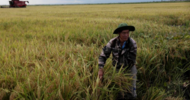
Former Director-General of FAO, José Graziano da Silva, and the former President of IFAD, Kanayo F. Nwanze.
Access to Food and Intellectual Property Rights: Commentary on the Draft UNIDROIT/FAO/IFAD Legal Guide on Agricultural Land Investment Contracts
By Titilayo Adebola
This commentary considers the access to food component of the draft UNIDROIT/FAO/IFAD Legal Guide on Agricultural Land Investment Contracts (Guide) and voices its silence on intellectual property rights (IPRs). In the past decade, foreign investors have increased the number of investments in the long-term lease of arable land, especially in Africa, and in the Global South, generally. The reasons for the choice of these locations include the availability of large portions of inexpensive agricultural land, inexpensive local labour and favourable climatic conditions for crop production. The Guide proposes more responsible investments in agriculture from public and private sector investors as a way to achieve, inter alia ‘No Poverty’ and ‘Zero Hunger’ (Sustainable Development Goals 1 and 2).
The agricultural investment (investments), typically bilateral, involving an investor and a legal tenure right holder or a legitimate tenure holder, are in different forms, including investment contracts, concession agreements, community development agreements, contract farming and joint ventures. There are concerns that the agricultural land investment contracts are often negotiated or implemented in ways that fail to involve all holders of tenure rights or properly balance policy goals such as promoting food security, protecting the environment, safeguarding the rights of legitimate tenure right holders and stimulating economic goals. A critical analysis of the investments and concomitant contracts uncover social, economic, ethical and political complexities. Nevertheless, the Guide proposes the amelioration of food security concerns and complexities through ex ante human rights impact assessment.
Access to Food: Human Rights Impact Assessment
According to the Guide, a ‘human rights impact assessment can assess the extent to which agricultural investments affect local access to food, especially if an investment project causes them to lose access to land on which they grow their food’ (see also: VGGT Technical Guide No. 7 FAO, 2016). An investment that promotes the human right to food would inter alia provide for the increase in sustainable production, production of safe and nutritious food as well as fairness, transparency and efficiency in the markets. The proposed human rights impact assessment would delineate States positions on responsible investments that espouse the right to food (see also: VGGT Provision 12.4 FAO, 2012).
While the proposed human rights assessment is laudable, it is not clear whether the food crops produced would be for domestic consumption in the host States or export markets. This is crucial ‘vis-à-vis’ responsible investments because many host States, for example, in Africa, are heavily dependent on food importation or worse, food aid. To achieve the overarching aim of responsible investments alongside the Sustainable Development Goals 1 and 2, the domestic realities and interests of these host States should be prioritised. Two suggestions are proffered here. First, investors should dedicate the core of their investments to the production of domestic staple food crops. Put differently, the production of food crops should respond to local needs. In the words of Oliver De Schutter (United Nations Special Rapporteur on the Right to Food, 2008 – 2014) ‘it is only to the extent that investments can improve local food security by increasing productivity and serving local markets …. that they are justified.’ Second, the Guide should provide clear direction on the distribution of food products. A two-step distribution strategy is suggested. Meeting domestic consumption demands should be a compulsory first-step ahead of the export market demands. Explicit provisions should be made to specify the percentage of production for domestic consumption and when/how the domestic demands would be deemed to have been met. This two-step strategy aligns with Article 11 of the International Covenant on Economic, Social and Cultural Rights that provides for States to ensure the right of everyone to adequate food by improving the methods of production, conservation and distribution of food. Significantly, it provides that the problems of both food-importing and food-exporting countries be considered to ensure an equitable distribution of food supplies in relation to their need.
Intellectual Property Rights and Impact Assessments
Notably missing from the impact assessments furnished in the Guide is the potential impact of investments on IPRs. Research on IPRs for plant varieties in the Global South find that agriculture investments have precipitated the introduction of the International Convention on the Protection of New Varieties of Plants, 1991 (UPOV) styled plant breeders’ rights systems. UPOV, 1991 grants strong plant breeders’ rights and limits small-scale farmers rights to save, reuse, exchange or sell farm-saved seeds, which are fundamental to their farming practices and livelihoods. Regardless of the percentage of small-scale farmers in host States or their prevalent traditional farming practices, investors backed by multinational seed/chemical/fertiliser companies, often lobby for the introduction of UPOV-1991 styled IPRs systems. UPOV is advertised as ‘the’ IPRs for plant varieties system that will incentivise investments, resulting in its inclusion as a condition for agricultural investments.
Consider, for example, the United Republic of Tanzania (Tanzania) where about 75 per cent of its population is involved in agriculture, made-up primarily of small-scale farmers who cultivate about 91 per cent of the arable land and contribute about 26.5 per cent of the gross domestic product. Tanzania earmarked agriculture as one of the core sectors to drive its economic transformation in its Tanzania Development Vision 2025. Consequently, it launched domestic initiatives such as the Tanzania Agricultural Food Security Implementation Plan 2011 and signed investment agreements such as the G8 New Alliance for Food Security and Nutrition in Africa, 2012 (NAFSN). The NAFSN sets out to unlock private investments in agriculture in Africa and operates through ‘country cooperation frameworks’ where members outline their commitments. Tanzania alongside the nine other participating African States (Burkina Faso, Benin, Cote d’Ivoire, Ethiopia, Ghana, Malawi, Mozambique, Nigeria and Senegal) submitted their ‘policy commitments’, while companies and donor agencies, such as Monsanto, Syngenta and Yara International, outlined their intended investments in ‘letters of intent.’ For its part, Tanzania committed to introducing a plant breeders’ right system styled on UPOV 1991. It fulfilled this commitment through its Plant Breeders’ Rights Act of 2012; it subsequentlyjoined the International Union for the Protection of New Varieties of Plants on 22 November 2015, becoming its first least-developed country member. Drawing from the background on the agricultural realities in Tanzania mentioned above, civil society organisations assert that the adoption of the UPOV 1991 styled plant breeders’ right system is unsuited to the State.
Accordingly, it is suggested that the Guide includes IPRs as one of the types of impact assessments relevant to agricultural land investment contracts, with the following revisions to page 43.
2.95. Five types. There are five types of impact assessments relevant to agricultural land investment contracts: (a) environmental (b) social (c) human rights (d) intellectual property rights and (e) economic.
(d) Intellectual property rights: closely linked to the human rights impacts, IPRs impact assessments are necessary because stronger IPRs systems are often an offshoot of agricultural investments. One principal benefit of recognising and undertaking an IPRs impacts assessment is that it considers the interests of all stakeholders, including the often marginalised resource-poor small-scale farmers and farming communities. The impact assessments will include effects of IPRs systems on farmers’ rights to save, reuse, exchange and sell farm-saved seeds and propagating materials. It will also include the effects of IPRs on the recognition and reward of traditional knowledge, biological diversity, cultural diversity, small-scale farmers, farming communities and indigenous peoples, which are all fundamental elements of traditional farming practices and informal seed systems.
(d) Intellectual property rights: closely linked to the human rights impacts, IPRs impact assessments are necessary because stronger IPRs systems are often an offshoot of agricultural investments. One principal benefit of recognising and undertaking an IPRs impacts assessment is that it considers the interests of all stakeholders, including the often marginalised resource-poor small-scale farmers and farming communities. The impact assessments will include effects of IPRs systems on farmers’ rights to save, reuse, exchange and sell farm-saved seeds and propagating materials. It will also include the effects of IPRs on the recognition and reward of traditional knowledge, biological diversity, cultural diversity, small-scale farmers, farming communities and indigenous peoples, which are all fundamental elements of traditional farming practices and informal seed systems.
To further establish the significance of IPRs to agricultural land investment contracts, it is suggested that other parts of the Guide, such as relevant sections of pages 10, 18 and 22 to 24, refer to IPRs as indicated below.
Page 10. Preface 2. Context… Indeed, there are many important considerations, including possible investment models, different applicable legal frameworks depending on the investment’s location and gaps in such frameworks or their implementation, as well as the investment’s potential impact on tenure rights, intellectual property rights, food security and the progressive realisation of the right to adequate food, livelihoods and the environment…
Page 18. 1.1 Overview. An appropriate and effective legal framework can foster responsible agricultural investment and incorporate necessary safeguards to protect legitimate tenure right holders, human rights, intellectual property rights, livelihoods, food security and the environment…
Pages 22 to 24. Include IPRs as one of the ‘Relevant Areas of Law.’
1.1. Intellectual Property Rights. Parties may not expressly include IPRs provisions in contracts; however, the protection of planting materials is a core component of large-scale agriculture businesses. The main IPRs systems favoured by large-scale agriculture businesses are patent systems and plant breeders’ rights systems set out in UPOV 1991. These systems are unsuited to Global South States for a variety of reasons. Alternative systems better suited to such States include imaginatively-designed sui generis IPRs systems that incorporate farmers rights, traditional knowledge protection alongside access and benefit-sharing principles drawn from the International Treaty on Plant Genetic Resources for Food and Agriculture 2001, Convention on Biological Diversity 1992, as well as the Nagoya Protocol on Access to Genetic Resources and the Fair and Equitable Sharing of Benefits Arising from their Utilisation to the Convention on Biological Diversity 2010. Albeit dated, the African Model Legislation for the Protection of the Rights of Local Communities, Farmers and Breeders, and for the Regulation of Access to Biological Resources 2000 provides guidelines in this regard. It is essential to assess the IPRs systems States already have in place and to consider the inclusion of safeguards in agricultural land investment contracts or related agreements, that prohibit investors from (directly and indirectly) pressuring or coercing States to adopt preferred IPRs systems.
Conclusion
The Guide reflects the commitment of its drafters to present nuanced information and detailed guidance on the essential components of agricultural land investment contracts and its potential implications. This commentary covers the access to food component of the Guide and highlights its silence on IPRs implications. It proffers three suggestions. First, the Guide should include provisions that specify the types of crops produced by investors. Investors primary commitment should be to produce domestic staple food crops that cater to host States needs and improve their national food security. Second, the Guide should include provisions that specify the distribution of the food crops produced. Domestic consumption should be prioritised ahead of export market demands. Third, the Guide should include IPRs in its impact assessments and discourse. With the proliferation of agricultural land investments, this Guide is a commendable intervention, which has the potentials to achieve its objectives.












